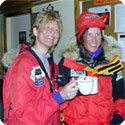
by
Ellyn Hament
In
1935, Caroline Mikkelsen, wife of a Norwegian whaling captain,
became the first known woman to set foot, briefly, in Antarctica—but
not the first person. A man had stepped onto the continent
more than a hundred years earlier, and men had begun the "heroic
era" of Antarctic exploration decades before. It’s
only recently that women have arrived, literally and figuratively,
on The Ice.
The
first women to winter on the continent, half a century after
the first men, were Americans Edith Ronne and Jennie Darlington,
wives of Ronne Antarctic Research Expedition members. Writing
about her 1947 adventures in
My Antarctic Honeymoon
,
Darlington lamented: "Taking everything into consideration,
I do not think women belong in Antarctica."

|

|
|
|
|
|
|
Women
researchers relaxing at McMurdo Station.
|
|
|
|
She
wasn’t alone in this sentiment. For centuries, many men
(and women) believed that Antarctica’s punishing environment
would be too tough for "the weaker sex" to endure.
Some people also believed women would crumble in a crisis,
fight with each other, complain of boredom, or instigate sexual
encounters. In the twentieth century, the argument was added
that there were no facilities for women. These attitudes were
enough to keep women out of Antarctica for a very long time.
In
the 1950s, only one woman, a Russian marine geologist named
Marie V. Klenova, made it ashore. Russian women had sailed
on whaling ships in Antarctica’s oceans earlier in the
century, paving the way for the country’s female scientists.
Klenova joined a Soviet oceanographic team on a Russian icebreaker
in 1956, mapping unchartered areas of the Antarctic coastline
and coming ashore periodically at a Russian base. Eventually,
Klenova’s research helped form the first Antarctic atlas,
published by the Soviet Union.
|
